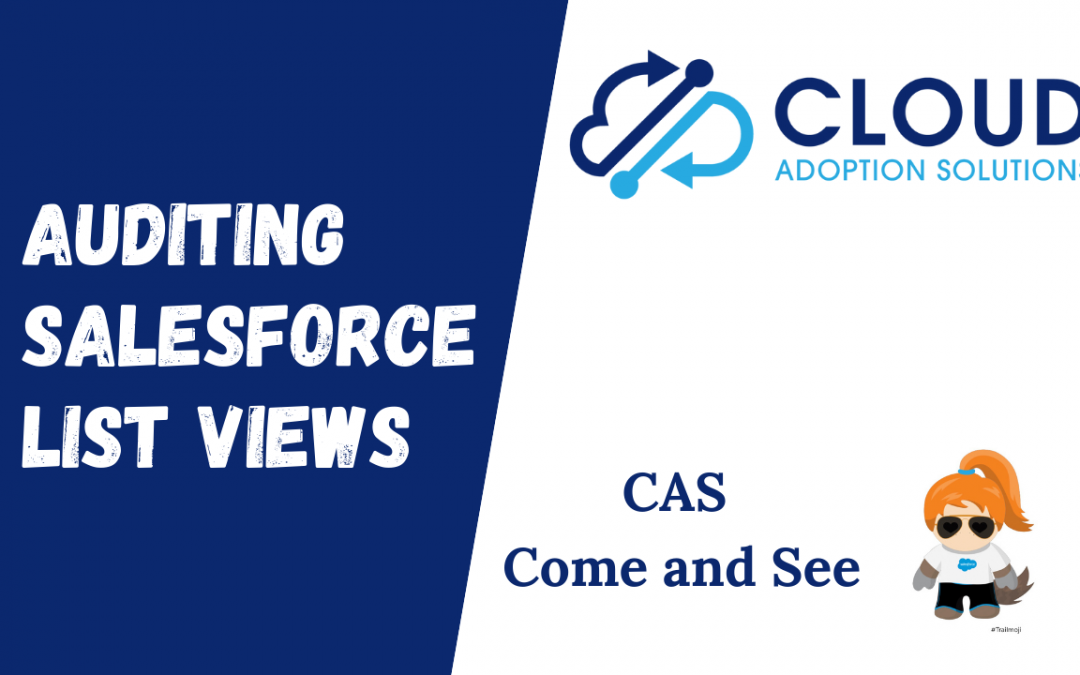Auditing Salesforce Listviews: CAS Come and See Video
Why should I audit my Salesforce List Views? How can I audit my Salesforce List Views? Salesforce Admins should audit the listviews in their org on a regular basis. Some reasons you may want to use Flow with your targeted emails:
- you’re an SDR or BDR sending multiple people the same prospecting message
- you are a service agent that needs to communicate an approved message to a targeted group of clients
- your “copy and paste” into gmail or MS Outlook is getting annoying and you want to spend your time more wisely
Join Natalie as she shows you the why and how to audit Salesforce list views in this CAS Come and See video – she fills you in on how you can better optimize your Salesforce instance.
Contact us with your Salesforce challenges at info@cloudadoption.solutions – we love to help!
Cloud Adoption Solutions is a 100% woman-owned registered Salesforce partner, specializing in implementation, integration, and optimization for Technology, Healthcare/ Life Sciences, and Financial Services/ Professional Services organizations in the small and mid-commercial sectors.
VIDEO TRANSCRIPT:
Natalie Battista 0:00
Hey, guys, this is Natalie with Cloud Adoption Solutions. And today I have another admin, quick tip for you, involving auditing list views. So, we’re going to go through why I would want to audit my list views. How do I audit them and the frequency. So the when the reason this is important, so many times we give our users access to things such as list views, not knowing that giving them that access allows them to change global list views or the public list views. So you may look at your org and see something similar to what’s on the screen here, where it says copy of this is what happens when a user is cloning a ListView. And doesn’t necessarily understand that they need to change the naming convention, they may not understand how to use the filters.
So why do we want to audit our list views? Basically, we need to clean them up for Standardization purposes. We want all of our users to see the same things. So whether I’m under the leads tab or the Account tab, we want to make sure that users are seeing the right columns. Is the information accurate? Are the filters filtering properly. And last ease of maintenance for you as the admin, if you’re conducting this audit on a monthly or quarterly basis, if you have these list views cleaned up, and then you lock down the access to them, then your jobs gonna be a little bit easier going through the year. So how do I audit my list views, the first thing you need to do is export them using a third party tool such as the Data Loader, want to do the export, you’ll have a spreadsheet where you can organize the sheet in the tabs for the objects that you’re looking at.
So let’s say you want to audit your accounts, opportunities, contacts leads, I would just create a tab for each object, and then highlight your columns where you’re going to have the ListView name, sharing settings, columns and filters. That way you have everything in one spot, and then just start reviewing them. So when should I audit my list views? Best bet here is to take on one object at a time because it could be a little bit complex once you get into the org. So start with your accounts or start with something that you know, that you’re comfortable with. Make sure you get feedback from your users too, because once you audit these list views, you’re more likely going to be making some changes to make things you know easier to see you’re going to be switching around some columns. Try to do one per week, if not do one a month that way now may take you a year to get through 12 objects, but at least you’re getting it done. And list, what you’d like to accomplish here is creating some governance around your list use. So if your users have access to create an edit all global list views could be something you may want to rethink. Now, by all means we do want them to be able to create a list view for themselves, you know, clone it, and being able to see the data that they need to see. But you don’t necessarily want them touching a global list view because if they make changes to it, that means everyone sees those changes. And those changes may not be pertinent to all users.
Hopefully this was helpful and gives you some insight into what an admin does, you know, throughout the day, month, year. As always, please visit our website at cloudadoption dot solutions. We are always happy to help. Thank you!
SUMMARY KEYWORDS:
Salesforce, Salesforce emails, Salesforce list views, Salesforce listviews, Salesforce Admin, Salesforce.com, SFDC


Recent Comments